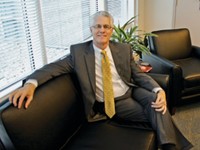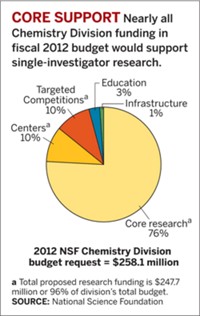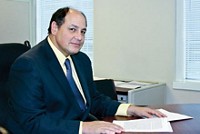Advertisement
Grab your lab coat. Let's get started
Welcome!
Welcome!
Create an account below to get 6 C&EN articles per month, receive newsletters and more - all free.
It seems this is your first time logging in online. Please enter the following information to continue.
As an ACS member you automatically get access to this site. All we need is few more details to create your reading experience.
Not you? Sign in with a different account.
Not you? Sign in with a different account.
ERROR 1
ERROR 1
ERROR 2
ERROR 2
ERROR 2
ERROR 2
ERROR 2
Password and Confirm password must match.
If you have an ACS member number, please enter it here so we can link this account to your membership. (optional)
ERROR 2
ACS values your privacy. By submitting your information, you are gaining access to C&EN and subscribing to our weekly newsletter. We use the information you provide to make your reading experience better, and we will never sell your data to third party members.
Environment
NSF Chemistry Gets New Leader
Clemson professor Luis Echegoyen takes control of division, unveils plans to reverse funding trend, advance research frontiers
by Susan R. Morrissey
November 27, 2006
| A version of this story appeared in
Volume 84, Issue 48
You don't have to talk to Luis A. Echegoyen long before you realize he is passionate about all things chemistry. It's more than just the twinkle in his eye or the smile on his face; it's the excitement in his voice that captivates the listener. This ability to engage people will serve the chemistry community well during his two-year term as the director of the Chemistry Division at the National Science Foundation.
Fueled by his passion, Echegoyen has hit the ground running. He's already made it clear that he plans to focus his efforts on reversing the relative downward funding trend that the division has seen over the past few years. He has also outlined four initiatives that he plans to work on during his term as director.
Echegoyen came to NSF from Clemson University, where he was chairman of the chemistry department. There, he retains an active research laboratory with six graduate students and four postdocs who focus on supramolecular and fullerene chemistry. The group has published 25 papers so far this year.
He joined the division in August, filling the vacancy created when Arthur B. Ellis left in June after serving for two terms. Ellis is now the vice chancellor for research and professor of inorganic chemistry at the University of California, San Diego.
"The toughest part of this job is going to be following in Art's footsteps," Echegoyen says. "Everyone remembers him very fondly and positively, so it will be a challenge to replace him."
One thing that will help Echegoyen meet that challenge is his previous experience at NSF. In 1982, he served as a visiting program officer, or rotator, in the Chemistry Division. He also served as a member of the NSF Chemistry Advisory Committee in the late 1980s and has maintained close ties with the foundation.
His experience will be an asset as he begins working on meeting his outlined objectives. His success, however, will also hinge on his ability to develop innovative and creative approaches to tackling perennial problems such as tight budgets and minority representation in chemistry. For these, he will draw on lessons learned early in his life.
Born in Cuba, Echegoyen and his family moved to Puerto Rico when he was 10 years old to avoid the Communist rule of Fidel Castro. He earned his B.S. degree from the University of Puerto Rico, Rio Piedras, in 1971 and continued there for his Ph.D., which he earned in chemistry in 1974.
His Hispanic heritage is something he is proud of and that he credits with helping him to be very imaginative. Because Puerto Rico was not an affluent place, he explains, resources for chemical research were limited. This scarcity forced him to be innovative, creative, and self-motivated.
"I remember doing a distillation one day when there was no longer any water" available in the lab to run through the condenser, he recalls. "So, we filled the condenser with acetone and blew nitrogen through it to cool off the system."
This ability to get the job done with available resources will be tested almost immediately as Echegoyen begins working on the Chemistry Division budget.
"My number one goal-and the main reason for accepting this job—is to try to reverse the relative downward budgetary trend in chemistry," Echegoyen says. He notes that every division at NSF has been pinched by the recent tight budget environment, but he points out that chemistry has been particularly affected by the squeeze.
"One way to reverse this trend," he explains, "is to come up with something in chemistry that really catches everybody's attention." Other disciplines have been able to identify overarching research objectives, he notes, but chemistry has not been successful in articulating one.
"If you go back and look at what the community has done, you find reports like the National Academies' 'Beyond the Molecular Frontier,' which was an excellent study. At the end of this report there is a list of grand challenges, but there are way too many of them," he explains. He acknowledges that pinning down just one of these challenges as the most compelling is not easy, because "chemistry is indeed the central science and it plays a role in energy, materials, biological systems, and many other areas."
But finding that one grand challenge is something Echegoyen is committed to and sees as necessary to increase chemistry's core funding. "I would like the chemistry community's input on this. We are looking for something that will really catch the attention of not only chemists, but also people from other disciplines," he says, adding that such suggestions can be e-mailed to him at chem-ideas@nsf.gov.
While Echegoyen works on developing a grand challenge, the division's budget looks to get some help from the Administration's American Competitiveness Initiative (ACI), which aims to double the budgets of key physical science agencies including NSF over the next decade (C&EN, March 6, page 57). Although Congress has not finalized the fiscal 2007 budget, the President's request for NSF would give it a healthy 7.7% increase to $6 billion for research and related activities, and the Chemistry Division would get a 6.8% increase to about $191 million.
"Right now, the budget atmosphere is very positive, but it's mostly ACI driven," Echegoyen notes. He cautions that if the ACI-related legislation and appropriations don't materialize, "it will have demoralizing effects."
Another factor that could affect the funds available to Echegoyen is the success of the division's Chemical Bonding Centers. This pilot program was started by the division in 2004 to target highly innovative, large-scale research projects (C&EN, Oct. 11, 2004, page 33). Three of the originally selected projects are now eligible to apply for the second phase of the program, which carries an award of up to $3 million per year for five years.
"We are in the process of evaluating the phase II proposals that we received, and it's impossible to predict what's going to happen," Echegoyen says. But, he notes, the community should be aware that if any or all of these phase II proposals are funded, the centers could claim a substantial portion of the expected 2007 budget increase. This would mark a shift in the division's budget portfolio to more center funding, which has been a small portion historically.
In addition to trying to increase the budget, Echegoyen will focus his efforts on four new initiatives. He emphasizes that although the initiatives will outline targeted thrust areas, they will not involve new solicitations with set-aside funds.
"I don't want to start creating different areas with different pots of money, because at the end of the day, all of the money comes out of the same pocket," he says. Instead, he believes that proposals spawned from any new initiative should go through existing division programs.
Echegoyen's first new initiative deals with increasing the international reach of chemistry. "I am convinced the world is flat, and chemistry needs to be much flatter than it is right now," he says, adding that the division has not done well enough reaching across international borders given today's trends toward globalization.
One example of the kinds of activities that Echegoyen would like the Chemistry Division to do more of is a joint effort started last year with NSF's German counterpart, the Deutsche Forschungsgemeinschaft (DFG). This program involves proposals from projects including at least one American and one German scientist. The proposals are jointly reviewed, selected, and funded by the Chemistry Division and DFG.
"The program was very successful," and no division money was set aside specifically for it, Echegoyen explains. The joint venture, which just issued its second call for proposals, funded five projects last year.
Echegoyen is working to expand this type of collaboration to other countries in Europe, Asia, and Central and South America, but he says that including more countries raises some challenges. "Language and traditions can become issues. For example, with European countries, we have a lot of commonality, but there are a lot more problems when Asian countries come into play," he says.
To help deal with this issue, Echegoyen plans to pull from a model used by NSF's Division of Materials Research. "For a long time, DMR has had what they call the Materials World Network," he points out. This network has about 50 countries signed on as potential collaborators for materials research projects and could provide a framework for such collaboration through the Chemistry Division.
Another international project Echegoyen and the division are working on involves NSF's Research Experiences for Undergraduates (REU) program. Here, the division is partnering with the German Academic Exchange (DAAD) to join the REU program with DAAD's Research Internship in Science & Engineering program (RISE). The hybrid REU-RISE program would send American students to Germany and German students to the U.S. for the summer to do research. The program is expected to launch this summer.
Echegoyen is also tackling the issue of minority representation in chemistry. "I've been in this business now for a long time, and the progress in this area is at best marginal," he says. "We collect data and write report after report, but nothing seems to change."
As part of his initiative in this area, Echegoyen and the division staff are putting together a workshop that approaches the problem in a novel way. The workshop will build on a meeting in January that brought together chemistry department chairs to focus on gender equity in chemistry departments (C&EN, Feb. 13, page 65).
"The gender-equity workshop," Echegoyen explains, "sensitized people to the idea that we are all biased. I attended it as a department chair, and before it started, I would have told you that I am not biased at all, but now I realize I am."
Once eyes were opened to inherent biases, the group was able to more effectively find ways to increase the number of female faculty in chemistry. The issue of minority representation in chemistry could benefit from a similar realization, Echegoyen says.
"The biggest problem we face with minority representation is the fact that people have come to believe that they are not biased, and that's dangerous," Echegoyen says. Once people realize they do have biases, he explains, the workshop will look at ways to get more minorities into chemistry early on.
Echegoyen's initiatives also include two scientific drivers. The first focuses on molecular electronics. According to him, this field is at the point where it is ready to move its frontier.
"People have now reproducibly shown that you can take a single molecule and measure properties like conductance and make single molecules act as molecular transistors," he explains.
"We're ready for a new push, where we can combine self-assembly with single-molecule measurement and device fabrication," he says. He is considering holding a workshop in this area to focus research efforts for the future.
The second science-based initiative Echegoyen is targeting is in the area of complexity and emergent phenomena in chemistry. "Supramolecular chemistry is pretty good at measuring and predicting the specific interactions between two molecules, but when we get into more complex assemblies, very little is known," he says, speaking from experience as a supramolecular chemist.
The goal of this initiative is to correct that limitation. Specifically, he wants to focus efforts on understanding how carefully prepared molecules can be mixed to form complex materials with properties that are different from those of their parts. A workshop is also in the planning stages at the present time.
In addition to his new initiatives, the division will continue its efforts in other areas, such as sustainability, Echegoyen points out. "We also feel that chemistry is at the heart of sustainability," he says. "We've held two workshops in this area, and we will entertain proposals in fields related to sustainability." He adds that, again, these proposals will not be part of a separate program with a separate budget, but rather they will be processed through existing programs.
But Echegoyen's job is not just about setting up goals and directing the division, it's also about being an ambassador to the chemical community. A key task in this role is to dispel myths about how NSF and the division really work.
Advertisement
"One of the biggest myths the community believes is that the Chemistry Division is investing too much of the resources into so-called group or center grants," Echegoyen says. "If one looks back in time, the percentage invested in single investigator awards has held essentially steady at about 80% for single-investigator awards," he says, noting that this includes Collaborative Research in Chemistry awards that are made to small groups of fewer than four researchers. As for center awards, Echegoyen says the division spends only 4% of its funds in this mode and 13% in shared instrumentation facilities.
Another misconception is that the low success rate is somehow related to the quality of the division staff. "With a proposal success rate of 27% last year, the same rate as the year before, there is a justified frustration in the community since essentially three out of every four proposals have to be declined," he explains.
The reason for this decline has nothing to do with the staff but rather to an increase in the number of proposals for a constant number of grants. "There is not much that can be done unless the budget increases," he points out.
As for the staff, Echegoyen has only good things to say. "The group of program officers making these very difficult decisions is fantastic, and they worry painfully about every decision they make," he says. "This group is extremely competent, cautious, and very hardworking."
The community should be very grateful for having such a conscientious and dedicated group working on their behalf, he says. "We're always looking for good rotators to serve as program officers, so please consider serving in that capacity if you can."
With a full plate of ideas and goals, Echegoyen is committed to improving the standing of chemistry within NSF and among the public at large. While he works to accomplish all that he has laid out, he is also working to balance his responsibilities as an academic adviser-something he is also truly committed to and not ready to give up. He expects to return to that role once his term at NSF is finished.
"My current plan is to return to Clemson when my two-year term is over," he says. But, he adds, "I'm old enough to know that I should never say never, because two years is a long time and a lot of things could change."








Join the conversation
Contact the reporter
Submit a Letter to the Editor for publication
Engage with us on Twitter